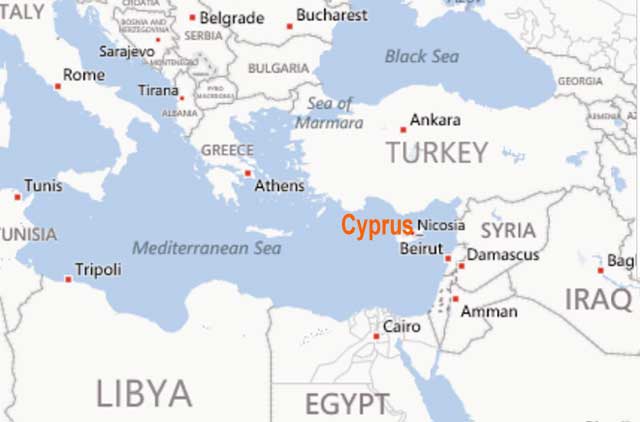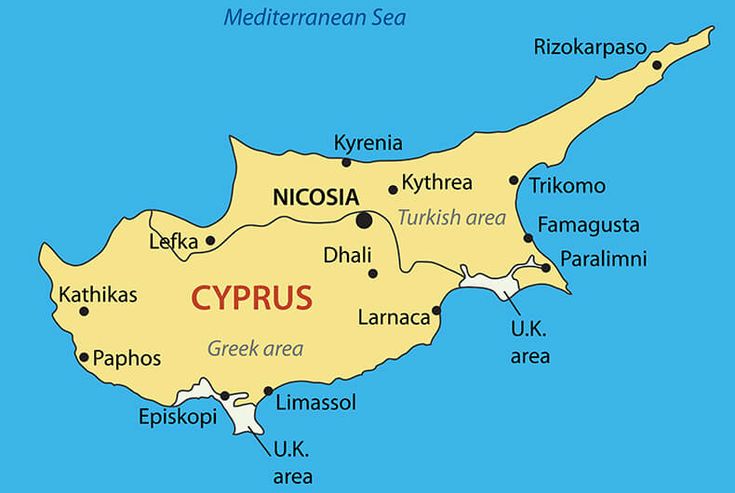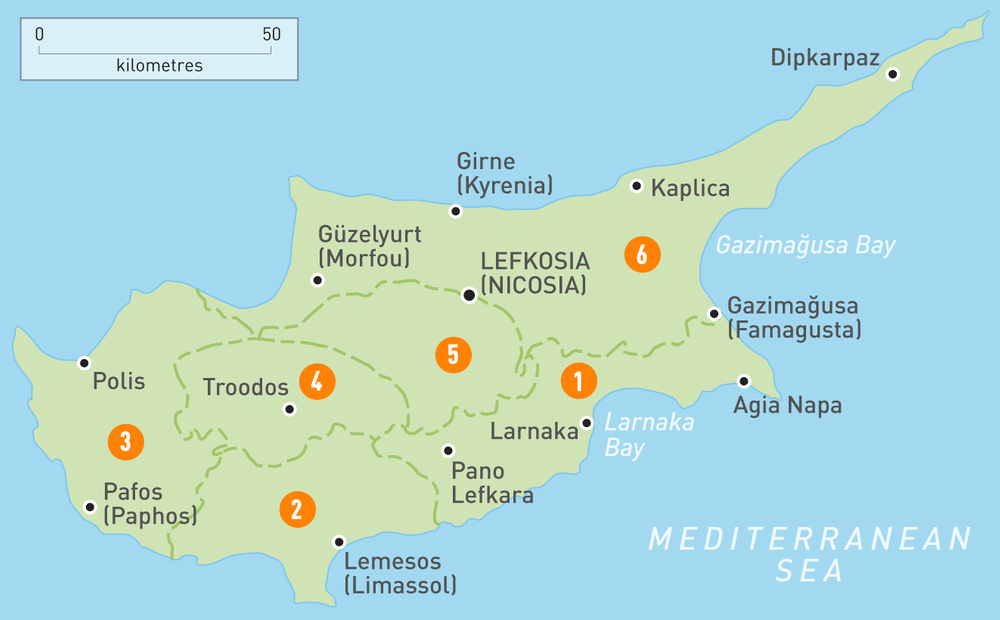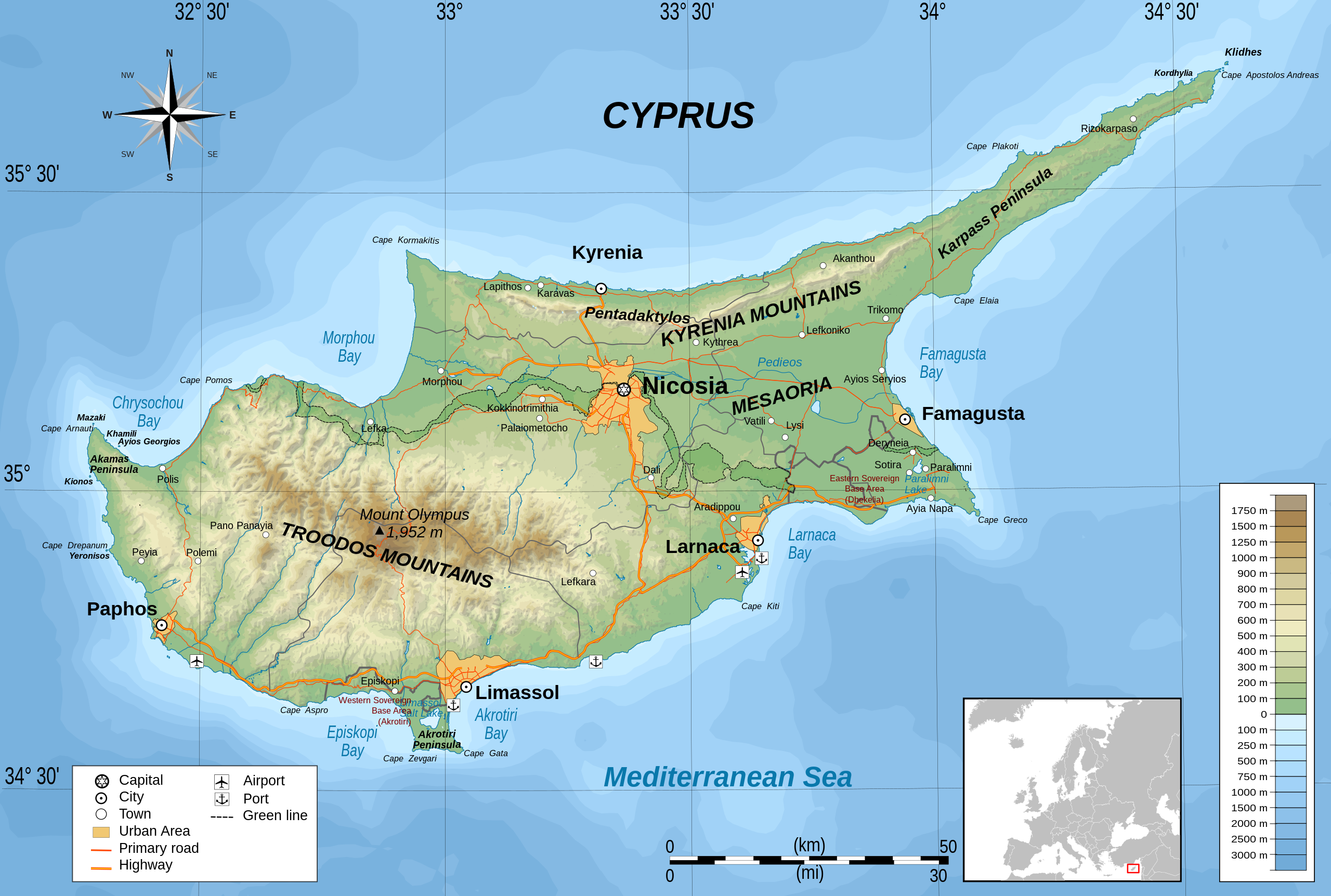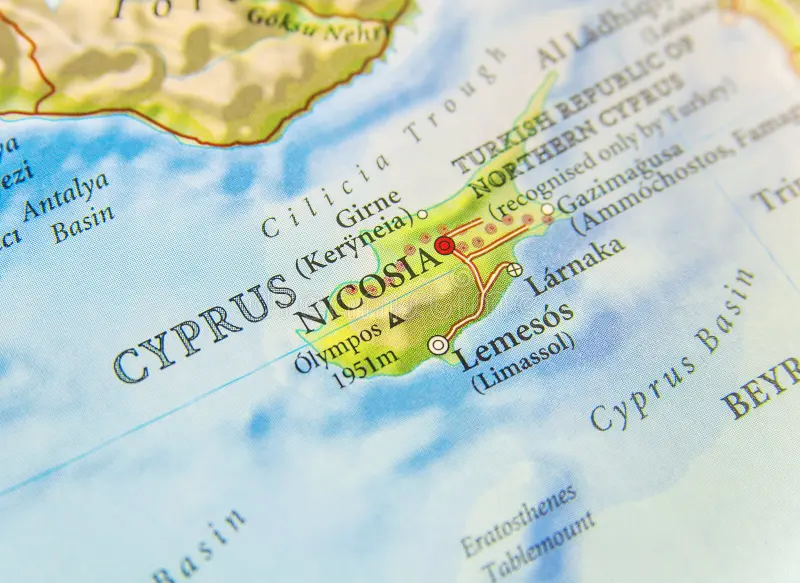Map Of Cyprus - History, Cities, Regions, And Fascinating Facts
Plan your journey with the map of Cyprus! Learn about its cities, regions, and fascinating facts to make the most of your visit to this beautiful island.
Author:Finn WildeReviewer:Michael RachalDec 25, 202412.7K Shares276.7K Views
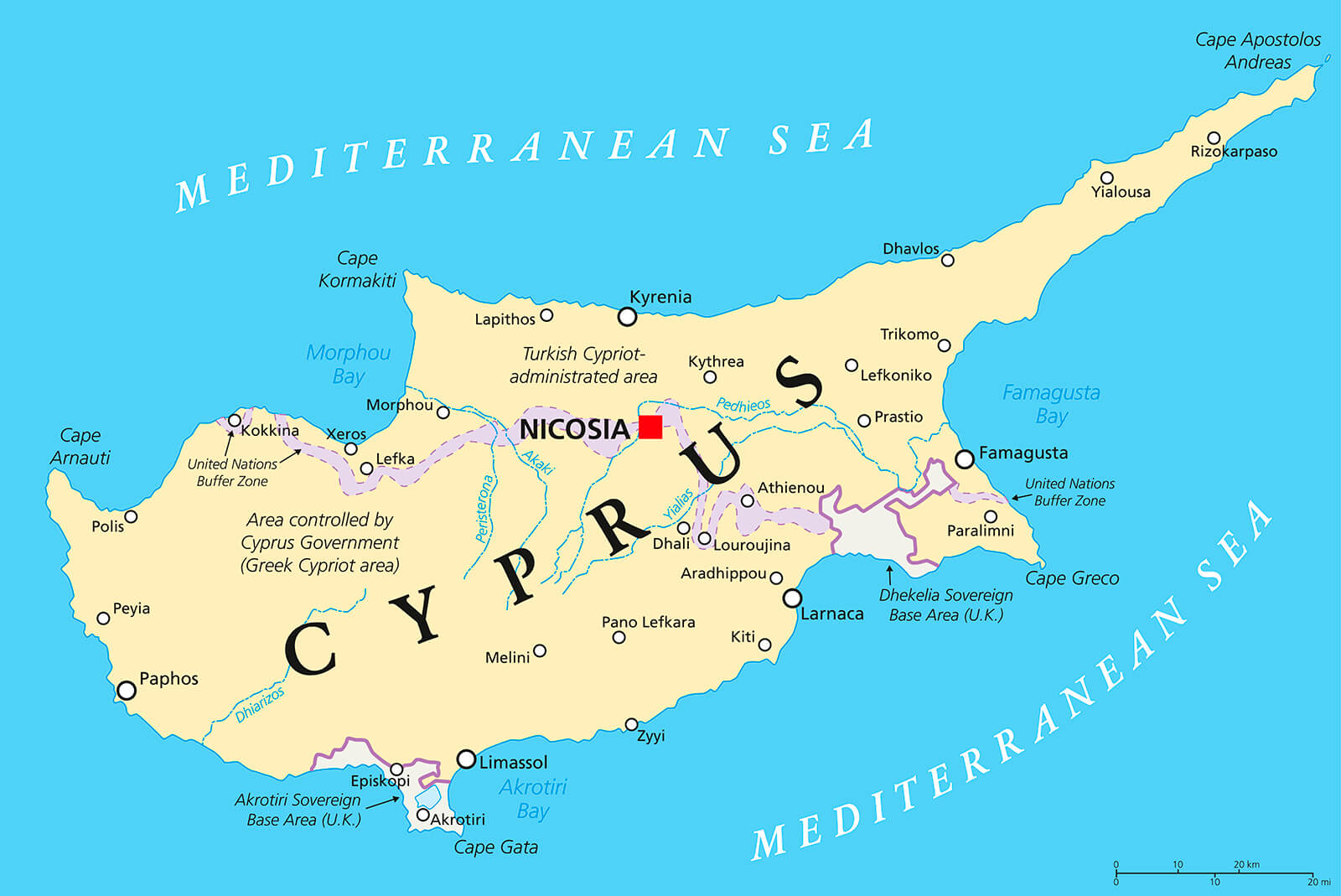
Cyprus is a Mediterranean treasure, known for its captivating landscapes, rich history, and vibrant culture. A closer look at the map of Cyprusreveals a fascinating blend of ancient landmarks, modern cities, and stunning natural features.
This guide offers an in-depth understanding of the island’s geography, key regions, and practical tips for travelers, helping you navigate this enchanting destination with ease.
Quick Facts About Cyprus
- Location: Cyprus is an island in the Eastern Mediterranean, situated at the crossroads of Europe, Asia, and Africa.
- Capital: Nicosia (Lefkosia) is the only divided capital city in the world.
- Population: Approximately 1.2 million people live in Cyprus.
- Official Languages: Greek and Turkish are the official languages, with English widely spoken.
- Currency: The Republic of Cyprus uses the Euro (€), while Northern Cyprus uses the Turkish Lira (₺).
- Climate: Cyprus enjoys a Mediterranean climate with long, hot summers and mild, rainy winters.
- Geography: The island spans 9,251 square kilometers, making it the third-largest in the Mediterranean.
- History: Cyprus is home to some of the world’s oldest archaeological sites, dating back to 9000 BCE.
- Green Line: The island is divided by the Green Line, a UN buffer zone separating the Republic of Cyprus and Northern Cyprus.
- Cuisine: Halloumi cheese, a Cypriot specialty, is famous worldwide.
- Tourism: Popular destinationsinclude Ayia Napa, Paphos, the Troodos Mountains, and the Akamas Peninsula.
- Mythology: Cyprus is considered the birthplace of Aphrodite, the Greek goddess of love.
- National Animal: The Cypriot Mouflon, a wild sheep, is a symbol of the island’s natural heritage.
- UNESCO Sites: The island has three UNESCO World Heritage Sites, including the Painted Churches in the Troodos Mountains.
- Salt Lakes: Larnaca and Akrotiri Salt Lakes attract flamingos during the winter months.
- Economy: The economy is driven by tourism, shipping, and financial services.
- Time Zone: Cyprus operates on Eastern European Time (EET), UTC+2.
- Driving: Cypriots drive on the left-hand side of the road, a legacy of British rule.
- Flora and Fauna: The island is home to diverse ecosystems, including endemic species like the Cyprus cedar and rare orchids.
- Festivals: Cyprus celebrates a range of festivals, from wine festivals in Limassol to cultural events in rural villages.
Geographical Overview Of Cyprus
Cyprus is a stunning island located in the Eastern Mediterranean, strategically positioned at the crossroads of Europe, the Middle East, and North Africa. It is the third-largest island in the Mediterranean, covering approximately 9,251 square kilometers (3,572 square miles).
Surrounded by the azure waters of the Mediterranean Sea, the island is renowned for its diverse landscapes, which include golden beaches, rugged mountains, and fertile plains. Its geographical position has made it a cultural and trade hub for millennia, attracting settlers, conquerors, and traders from various civilizations.
Map Of Cyprus Cities
1. Nicosia (Lefkosia)
Nicosia, the capital of Cyprus, is unique as the last divided capital in the world. It is bisected by the Green Line, separating the Republic of Cyprus in the south from Northern Cyprus.
The city is a cultural and administrative hub, with landmarks like the Venetian Walls, the Cyprus Museum, and the bustling Ledra Street. Nicosia blends modern urban life with historical charm, offering visitors a rich experience.
2. Limassol (Lemesos)
Limassol is a vibrant coastal city known for its beautiful beaches, marina, and lively atmosphere. As a key port city, it serves as a major business and trade center. Tourists flock to its medieval Limassol Castle, which houses the Cyprus Medieval Museum, and enjoy the city's renowned wine festivals.
The nearby Kolossi Castle and ancient city of Kourion add to Limassol's appeal. Its mix of historical landmarks, family-friendly attractions, and modern amenities makes it one of the top family travel destinations, offering something for visitors of all ages.
3. Paphos (Pafos)
Paphos is a UNESCO World Heritage Site famous for its archaeological treasures, including the Paphos Mosaics, Tombs of the Kings, and the ancient Odeon theater. This coastal city is also closely linked to Greek mythology as the birthplace of Aphrodite, the goddess of love. Paphos offers a mix of history, picturesque harbors, and serene beaches, making it a favorite for visitors.
4. Larnaca (Larnaka)
Larnaca is a serene coastal city known for its historical and natural attractions. It features the Larnaca Salt Lake, which attracts flamingos during migration season, and the Hala Sultan Tekke, a significant Muslim shrine. Visitors enjoy its beaches and the charming Finikoudes promenade lined with cafes and restaurants. Larnaca is also home to Cyprus’s main international airport, making it a gateway to the island.
5. Famagusta (Gazimağusa)
Located in Northern Cyprus, Famagusta is renowned for its walled city and medieval architecture. Visitors can explore the Gothic-style St. Nicholas Cathedral, which has been converted into a mosque, and the ancient ruins of Salamis, a once-thriving city-state. Famagusta’s rich history and sandy beaches make it an intriguing destination.
6. Kyrenia (Girne)
Kyrenia, a picturesque harbor town in Northern Cyprus, is known for its stunning marina, Kyrenia Castle, and scenic mountain backdrop. The castle houses a shipwreck museum and offers breathtaking views of the coastline. Kyrenia’s relaxed atmosphere, historic charm, and waterfront dining options make it a popular spot for tourists.
7. Ayia Napa
Ayia Napa is a lively tourist destination on the southeastern coast of Cyprus, famous for its golden beaches, vibrant nightlife, and family-friendly attractions. Nissi Beach and Makronissos Beach are top spots for sun-seekers, while the Ayia Napa Monastery provides a glimpse into the area’s historical roots. Water parks and boat tours add to the city’s allure.
8. Protaras
Protaras, located near Ayia Napa, is a quieter resort town ideal for families and couples. The famous Fig Tree Bay, with its crystal-clear waters, is a must-visit. Protaras also offers great snorkeling and diving opportunities. Its relaxed vibe and scenic coastal trails make it a perfect escape from busier cities.
9. Morphou (Güzelyurt)
Morphou, in Northern Cyprus, is known for its agricultural heritage and is often called the “Fruit Basket of Cyprus.” Visitors can enjoy the Güzelyurt Museum of Archaeology and Natural History and the nearby St. Mamas Monastery. Its tranquil surroundings and local festivals give insight into the region’s traditions.
10. Paralimni
Paralimni is a charming town near the eastern coast, serving as a hub for local culture and history. Its town square is home to several historic churches, such as the Church of St. George. Paralimni offers a quieter experience, with easy access to nearby beaches and resorts like Ayia Napa and Protaras.
11. Kokkina (Erenköy)
Kokkina, located in Northern Cyprus, is a small enclave known for its significance in Cyprus’s political history. It is surrounded by natural beauty, including rugged coastlines and small fishing villages. While not as touristy as other cities, it offers a glimpse into the region’s less-explored areas, making it a hidden gem for those seeking best places to travelthat combine history with untouched natural charm.
Regions On The Map Of Cyprus
1. Nicosia District (Lefkosia)
The Nicosia District is home to the island’s capital and largest city, Nicosia. This central region is unique for being divided by the Green Line, separating the Republic of Cyprus from Northern Cyprus. It’s the political, administrative, and cultural heart of the island, featuring landmarks such as the Venetian Walls, Ledra Street, and numerous museums. The district extends beyond the capital, encompassing traditional villages like Kakopetria in the Troodos Mountains.
2. Limassol District (Lemesos)
Located on the southern coast, Limassol District is known for its cosmopolitan vibe, vibrant marina, and cultural festivals. It is home to historical attractions like Limassol Castle and the ancient city of Kourion. The region also features stunning beaches and is a hub for wine production, with nearby vineyards in the foothills of the Troodos Mountains.
3. Larnaca District (Larnaka)
The Larnaca District is a gateway for international travelers, as it hosts the country’s main airport. It is known for its coastal charm, historical sites such as the Hala Sultan Tekke mosque, and natural wonders like the Larnaca Salt Lake. The district also offers serene beaches and picturesque villages like Lefkara, famous for its lacework and silverware.
4. Paphos District (Pafos)
Located on the southwestern coast, the Paphos District is steeped in history and mythology. It is a UNESCO World Heritage Site, featuring attractions such as the Paphos Mosaics, Tombs of the Kings, and the ancient Odeon theater. Paphos is also closely linked to Aphrodite, the goddess of love, with landmarks like Aphrodite’s Rock.
5. Famagusta District (Ammochostos)
Famagusta District, in the eastern part of Cyprus, is renowned for its golden beaches, lively resorts, and agricultural heritage. Key areas include Ayia Napa and Protaras, known for their vibrant nightlife and family-friendly attractions. Historically, the walled city of Famagusta in Northern Cyprus showcases Gothic architecture and ancient ruins.
6. Kyrenia District (Girne)
The Kyrenia District, located in Northern Cyprus, is famed for its picturesque harbor town of Kyrenia. This region offers scenic beauty with its mountain backdrop and coastal charm. Attractions include Kyrenia Castle, St. Hilarion Castle, and the ancient Bellapais Abbey. It is a popular destination for its mix of history and relaxation.
7. Morphou District (Güzelyurt)
Morphou, located in the northwest, is celebrated for its agricultural produce, particularly citrus fruits. It is one of the quieter regions on the map, offering visitors a peaceful retreat. Key sites include the St. Mamas Monastery and the Güzelyurt Museum, which houses archaeological and natural history exhibits.
8. Troodos Region
The Troodos Region, marked by its mountainous terrain, spans several districts and is a haven for nature lovers. The area features quaint villages like Platres and Kakopetria, as well as stunning trails and waterfalls. It is also home to several UNESCO-listed Byzantine churches and the island’s highest peak, Mount Olympus.
Capital Of Cyprus
The capital of Cyprus, Nicosia (Lefkosia), stands as a unique and historically significant city, renowned for being the only divided capital in the world. Located in the heart of the island, Nicosia is separated by the Green Line, a buffer zone patrolled by the United Nations, which divides the city into the Republic of Cyprus in the south and the Turkish-controlled Northern Cyprus in the north.
Population Of Cyprus
Cyprus has a population of approximately 1.2 million people, with the majority residing in the Republic of Cyprus in the southern part of the island. The population is ethnically diverse, with the two main groups being Greek Cypriots, who make up around 77%, and Turkish Cypriots, who comprise approximately 18%. The remaining 5% includes expatriates, Armenians, Maronites, and other minority communities.
Currency Of Cyprus
The official currency of the Republic of Cyprus is the Euro (€), which was adopted in 2008 when the country joined the Eurozone. This transition replaced the Cypriot pound, simplifying trade and travelwithin Europe. In Northern Cyprus, the official currency is the Turkish Lira (₺), aligning with its political ties to Turkey.
Dialing Code Of Cyprus
The international dialing code for the Republic of Cyprus is +357, used for all communication within its territory. In Northern Cyprus, the dialing code is +90, as it is aligned with Turkey’s telecommunications system.
Language Of Cyprus
The two official languages of Cyprus are Greekand Turkish, reflecting the island's ethnic and cultural diversity. Greek is predominantly spoken in the Republic of Cyprus, while Turkish is the primary language in Northern Cyprus. English is widely used across the island, particularly in urban centers, tourist areas, and businesses, making it easy for travelers to communicate.
Flag Of Cyprus
The flag of Cyprusis a powerful symbol of unity and peace. It features a white background with a copper-colored map of the island in the center, representing Cyprus’s rich natural resources, particularly copper, which has been mined there for centuries. Beneath the map are two green olive branches, signifying peace and reconciliation between the island's Greek and Turkish communities.
Government Of Cyprus
The Republic of Cyprus operates as a presidential republic, with the President serving as both the head of state and government. Elections are held every five years, with citizens electing the President and parliamentary representatives. The country has a unicameral legislative body known as the House of Representatives, responsible for enacting laws and policies. In contrast, Northern Cyprus has its own government system, recognized only by Turkey, with a similar presidential structure.
Total Area Of Cyprus
The total area of Cyprus is approximately 9,251 square kilometers(3,572 square miles), making it the third-largest island in the Mediterranean after Sicily and Sardinia. Its compact size belies its diverse geography, which includes stunning coastlines, rugged mountain ranges, fertile plains, and sprawling urban areas.
Major Roads And Transportation
Cyprus boasts a well-developed road network, making it easy for locals and tourists to navigate the island. Major highways, such as the A1, connect Nicosia to Limassol, while the A2and A3link the capital to Larnaca and the southeastern resort towns of Ayia Napa and Protaras. The A5and A6provide connections to Paphos and other western regions. These dual carriageways are efficient for long-distance travel, with clear signage in both Greek and English.
Types Of Cyprus Maps
Various types of maps showcase the diverse facets of Cyprus, each serving a unique purpose:
- Political Maps: Highlight the division between the Republic of Cyprus and Northern Cyprus, including the Green Line buffer zone.
- Topographical Maps: Focus on the island’s terrain, showing the elevation changes from the Troodos Mountains to coastal plains.
- Road Maps: Detail the extensive road network, including major highways connecting cities like Nicosia, Limassol, and Paphos.
- Climate Maps: Illustrate the island’s Mediterranean climate zones, differentiating between warmer coastal areas and cooler mountainous regions.
- Tourist Maps: Mark landmarks, beaches, and attractions, making them invaluable for visitors planning their itineraries.
- Interactive Digital Maps: GPS-enabled maps available on apps like Google Maps or Waze, offering real-time navigation and location-based information.
How To Use A Map Of Cyprus For Travel
1. Road Trips - Plan Scenic Drives From The Beaches To The Mountains
Cyprus is a haven for road trippers, offering scenic routes that connect vibrant cities, quaint villages, and breathtaking landscapes. A road map of Cyprus highlights major highways like the A1, which links Nicosia and Limassol, and the A6, which takes travelers to Paphos, a UNESCO World Heritage city.
2. Hiking - Use Topographical Maps To Explore The Troodos Range
Topographical maps are essential for hikers and nature enthusiasts exploring the Troodos Mountains. These maps detail elevation changes, trail paths, and natural landmarks, helping travelers navigate with confidence.
Popular trails, like the Artemis Trailand Caledonia Falls Trail, are marked with clear indications of difficulty levels and points of interest. Hikers can use these maps to locate hidden gems, such as Byzantine churches nestled in the mountains or quiet picnic areas with panoramic views.
3. Digital Maps - Apps Like Google Maps And Waze Are Highly Reliable
For modern travelers, digital maps offer unparalleled convenience and accuracy. Apps like Google Mapsand Wazeare widely used in Cyprus, providing real-time navigation, estimated travel times, and traffic updates. These tools are particularly helpful in urban areas like Nicosia and Limassol, where navigating busy streets and locating parking can be challenging.
Historical And Cultural Landmarks On The Map Of Cyprus
1. Tombs Of The Kings - An Ancient Necropolis In Paphos
The Tombs of the Kings, a UNESCO World Heritage Site, is one of Cyprus’s most iconic historical landmarks. Located near the coastal city of Paphos, this vast necropolis dates back to the 4th century BCE and was used as a burial site for high-ranking officials and wealthy families. The tombs are carved into solid rock and are adorned with architectural features like Doric columns and intricate frescoes.
2. Kykkos Monastery - Lavish Mosaics And Mountain Views
Nestled in the Troodos Mountains, the Kykkos Monasteryis a revered religious site and a masterpiece of Byzantine architecture. Founded in the 11th century, it houses one of the three surviving icons attributed to the Apostle Luke. The monastery is adorned with ornate mosaics, gilded icons, and frescoed walls, making it a visual feast for visitors.
3. St. Hilarion Castle - A Fairytale-Like Fortress In Northern Cyprus
Perched high in the Kyrenia Mountain range, St. Hilarion Castleis a stunning medieval fortress that inspired fairy tales and legends. Originally a monastery, it was fortified by the Byzantines in the 10th century to protect against Arab raids. The castle’s strategic location offers sweeping views of the coastline and the surrounding valleys.
4. Kolossi Castle - A Medieval Stronghold Near Limassol
Situated near Limassol, Kolossi Castleis a well-preserved medieval fortress that played a significant role in Cyprus’s history. Built in the 13th century by the Knights of the Order of St. John, it served as a military stronghold and administrative center. The castle is a testament to Gothic architecture, with its imposing square tower, thick stone walls, and inner courtyard.
Cyprus's Natural Wonders On The Map
- Aphrodite’s Rock (Petra tou Romiou): A breathtaking coastal formation near Paphos, Aphrodite’s Rock is steeped in mythology as the birthplace of the goddess of love, Aphrodite. It is a popular spot for swimming, photography, and enjoying stunning sunsets over the Mediterranean.
- Akamas Peninsula: Located in the west, this protected area is known for its rugged cliffs, crystal-clear waters, and ecological diversity. Highlights include Lara Bay, a nesting site for endangered loggerhead and green turtles, and hiking trails like the Aphrodite and Adonis Trails.
- Troodos Mountains: Dominating central Cyprus, the Troodos Mountains feature lush forests, charming villages, and Mount Olympus, the island’s highest peak at 1,952 meters (6,404 feet). Visitors can explore scenic trails, waterfalls like the Caledonia Falls, and UNESCO-listed Byzantine churches.
- Larnaca Salt Lake: This seasonal Salt Lake near Larnaca is transformed into a stunning habitat for migratory flamingos and other bird species during the winter months. Its serene beauty and surrounding walking paths make it a favorite for nature lovers.
- Avakas Gorge: A dramatic limestone canyon near Paphos, the Avakas Gorge is ideal for hiking and exploring. Its towering rock formations and diverse flora and fauna create a unique experience for adventurers and photographers.
- Cape Greco: Situated in the southeast, Cape Greco is famous for its sea caves, cliff diving spots, and panoramic views of the Mediterranean. It’s a top destination for snorkeling, scuba diving, and hiking along its scenic trails.
Cyprus Economy
The economy of Cyprus is a diverse mix of services, tourism, shipping, and agriculture, with services contributing over 80% of the GDP. As a member of the European Union, the Republic of Cyprus uses the Euro (€) and benefits from a stable financial system. Tourism is a cornerstone of the economy, drawing millions of visitors annually to its beaches, historical sites, and mountain villages.
Climate Map Of Cyprus
The climate map of Cyprus highlights the island's Mediterranean climate, characterized by long, hot summers and mild, rainy winters. Coastal areas, such as Limassol and Larnaca, experience moderate temperatures year-round, with summer averages around 30°C (86°F)and winter averages around 15°C (59°F).
In contrast, the Troodos Mountains in central Cyprus have cooler temperatures and even experience snowfall during winter, making them a popular destination for skiing.
Cyprus's Borders And Neighboring Countries
Cyprus is an island nation in the Eastern Mediterranean, surrounded by the Mediterranean Sea and lacking direct land borders. Its strategic location places it at the crossroads of Europe, Asia, and Africa. The island is approximately 75 kilometers (47 miles) south of Turkey, 105 kilometers (65 miles) west of Syria, 200 kilometers (124 miles) north of Egypt, and 800 kilometers (497 miles) southeast of mainland Greece. Known for its mild winters and diverse landscapes, Cyprus is also one of the ideal winter getaway spots, offering everything from sunny coastlines to snow-capped peaks in the Troodos Mountains.
National Parks On The Map Of Cyprus
1. Akamas Peninsula National Park
The Akamas Peninsula, located in the northwest of Cyprus, is one of the island’s most pristine natural areas. This protected park is renowned for its rugged coastlines, crystal-clear waters, and diverse flora and fauna. It is home to Lara Bay, a nesting site for endangered loggerhead and green turtles.
2. Troodos National Forest Park
Situated in the heart of Cyprus, the Troodos National Forest Parkencompasses the Troodos Mountains, including Mount Olympus, the highest peak on the island at 1,952 meters (6,404 feet). The park is known for its lush pine forests, waterfalls like the Caledonia Falls, and numerous hiking trails.
3. Cape Greco National Forest Park
Located on the southeastern coast near Ayia Napa, Cape Greco National Forest Parkis famous for its stunning sea cliffs and crystal-clear waters. The park is a hotspot for adventure activities like cliff diving, snorkeling, and scuba diving, with several underwater caves to explore.
4. Rizoelia National Forest Park
Situated near Larnaca, Rizoelia National Forest Parkis a smaller, yet significant green space known for its walking and cycling trails. The park features picnic areas, observation points, and diverse native vegetation. It is a great spot for families looking to enjoy outdoor activities close to urban areas.
5. Cavo Gkreko Environmental Center
While not a traditional national park, the Cavo Gkreko Environmental Centernear Cape Greco plays a vital role in educating visitors about the area’s unique ecosystems. It provides information on local marine and terrestrial habitats, helping visitors understand the region's ecological significance.
6. Machairas National Forest Park
Located near Nicosia, Machairas National Forest Parkis named after the historic Machairas Monastery, nestled within its boundaries. The park’s lush forested areas are perfect for hiking and picnicking, with trails like the Doxa si o Theostrail offering scenic mountain views. It’s also an excellent spot for birdwatching, with several endemic species found in the region.
7. Salt Lake Wetlands (Larnaca And Akrotiri)
The Larnaca Salt Lakeand the Akrotiri Salt Lakenear Limassol are key wetlands known for their ecological importance. These areas attract migratory birds, including flamingos, during the winter months. The wetlands are surrounded by walking paths and observation points, making them ideal for nature lovers and photographers.
8. Pafos Forest
The Pafos Forest, located in the western part of Cyprus, is a vast expanse of pine and cedar trees. It is home to the Cedar Valley, where visitors can find the endemic Cyprus cedar. The forest is a sanctuary for wildlife, including the endangered Cypriot mouflon. Hiking and off-road adventures are popular activities in this serene and untouched region.
9. Limassol National Forest Park (Polemidia)
This park, located near Limassol, offers a combination of green spaces and recreational facilities. It’s a popular spot for families and locals to enjoy outdoor activities, including picnicking, walking, and jogging. Its proximity to the city makes it a convenient escape into nature.
10. Kavo Greco Coastal Zone
Part of the Cape Greco region, the Kavo Greco Coastal Zoneis a protected marine area known for its underwater biodiversity. It is ideal for diving enthusiasts, with coral reefs and marine life creating a vibrant underwater world. The area also features breathtaking coastal landscapes perfect for photography.
Interesting Facts About Cyprus
- Birthplace of Aphrodite: According to Greek mythology, Cyprus is the birthplace of Aphrodite, the goddess of love and beauty. Aphrodite’s Rock, near Paphos, is a must-visit landmark linked to this legend.
- The Last Divided Capital: Nicosia, the capital of Cyprus, is the only divided capital in the world, split between the Republic of Cyprus and Northern Cyprus by the Green Line buffer zone.
- Oldest Wine in the World: Cyprus is home to Commandaria, the world’s oldest named wine still in production, dating back to over 4,000 years.
- Rich Archaeological Heritage: Cyprus boasts some of the oldest archaeological sites, including Khirokitia, a Neolithic settlement dating back to 7000 BCE and listed as a UNESCO World Heritage Site.
- A Haven for Flamingos: The Larnaca Salt Lakeand Akrotiri Salt Lake are seasonal havens for migratory flamingos during the winter months, creating picturesque natural scenes.
- Third Largest Mediterranean Island: After Sicily and Sardinia, Cyprus is the third-largest island in the Mediterranean, covering an area of 9,251 square kilometers.
- A Blend of Cultures: Cyprus is a melting pot of cultures due to its strategic location at the crossroads of Europe, Asia, and Africa, with influences from Greek, Turkish, British, and Middle Eastern civilizations.
- UNESCO-Listed Churches: The Troodos Mountains are home to ten Byzantine churches recognized as UNESCO World Heritage Sites for their stunning frescoes and historical significance.
- Driving on the Left: A remnant of British rule, Cypriots drive on the left-hand side of the road, making it one of the few European countries to do so.
- Halloumi Cheese Origin: Halloumi, a semi-hard cheese that doesn’t melt when grilled, originated in Cyprus and is one of its most famous culinary exports.
- Cypriot Mouflon: The Cypriot mouflon, a type of wild sheep found only in Cyprus, is a symbol of the island’s unique wildlife and features prominently in its culture.
- Incredible Sunshine: Cyprus enjoys over 340 sunny days a year, making it one of the sunniest places in Europe and a year-round destination for travelers.
- No Major Rivers: Despite its diverse landscapes, Cyprus has no major rivers, relying instead on reservoirs and water recycling for its water needs.
- Military Sovereign Bases: Cyprus hosts two British Sovereign Base Areas, Akrotiri and Dhekelia, which remain under British jurisdiction following Cyprus’s independence in 1960.
- Home to the Cyprus Rally: The Cyprus Rally, part of the FIA World Rally Championship, is a world-famous motorsport event held on the island’s challenging terrains.
FAQs
What Are The Main Regions On The Map Of Cyprus?
Cyprus is divided into two main regions: the Republic of Cyprus in the south and the Turkish Republic of Northern Cyprus in the north. The island is further divided into districts, including Nicosia, Limassol, Paphos, Larnaca, and Famagusta in the south, and Kyrenia, Famagusta, and Morphou in the north.
Is The Map Of Cyprus Divided?
Yes, Cyprus is divided by the Green Line, a buffer zone monitored by the United Nations. This line separates the Republic of Cyprus from the Turkish-controlled Northern Cyprus. Crossing points are available for travelers with valid documentation.
What Are The Most Prominent Landmarks Marked On The Map Of Cyprus?
Key landmarks include the Tombs of the Kings in Paphos, Kyrenia Castle in the north, Aphrodite’s Rock on the southern coast, and the Troodos Mountains with their Byzantine churches. National parks like the Akamas Peninsula and cultural sites like Nicosia’s Venetian Walls are also prominent.
Can I Use The Map Of Cyprus For Hiking Or Road Trips?
Yes, Cyprus maps are ideal for planning hiking routes in the Troodos Mountains or scenic drives along the coast. Topographical maps and digital navigation tools are particularly useful for outdoor activities and road trips.
Are There Interactive Maps Available For Cyprus?
Yes, several online platforms, including Google Maps and GPS-enabled apps, provide detailed interactive maps of Cyprus. These tools are great for real-time navigation and locating attractions.
Conclusion
Understanding the map of Cyprus unlocks a deeper appreciation for its unique geography and cultural richness. From ancient ruins and charming villages to breathtaking coastlines, every corner of this island offers something remarkable. Use the insights shared here to plan your journey, uncover hidden gems, and make the most of your experience in this Mediterranean paradise.
Jump to
Quick Facts About Cyprus
Geographical Overview Of Cyprus
Map Of Cyprus Cities
Regions On The Map Of Cyprus
Capital Of Cyprus
Population Of Cyprus
Currency Of Cyprus
Dialing Code Of Cyprus
Language Of Cyprus
Flag Of Cyprus
Government Of Cyprus
Total Area Of Cyprus
Types Of Cyprus Maps
How To Use A Map Of Cyprus For Travel
Historical And Cultural Landmarks On The Map Of Cyprus
Cyprus's Natural Wonders On The Map
Cyprus Economy
Climate Map Of Cyprus
Cyprus's Borders And Neighboring Countries
National Parks On The Map Of Cyprus
Interesting Facts About Cyprus
FAQs
Conclusion

Finn Wilde
Author
For Finn Wilde, the wilderness is more than just a destination - it’s a way of life. Over the past decade, he has led multiple expeditions in some of the world’s most remote regions, from the icy fjords of Greenland to the rugged trails of Patagonia.
Finn emphasizes sustainability in all of his adventures, helping participants connect with nature while promoting responsible exploration. His expeditions inspire individuals to explore the great outdoors while fostering a deep respect for the environment.

Michael Rachal
Reviewer
Michael Rachal believes that luxury lies in the details. With over 20 years of experience in the luxury travel industry, he has crafted hundreds of bespoke itineraries for clients seeking personalized, unforgettable experiences.
Whether guiding clients through private cultural tours or curating culinary journeys with world-renowned chefs, Michael ensures that each trip is tailored to perfection.
His ability to anticipate needs and exceed expectations has earned him a reputation as a leading expert in luxury travel.
Latest Articles
Popular Articles
